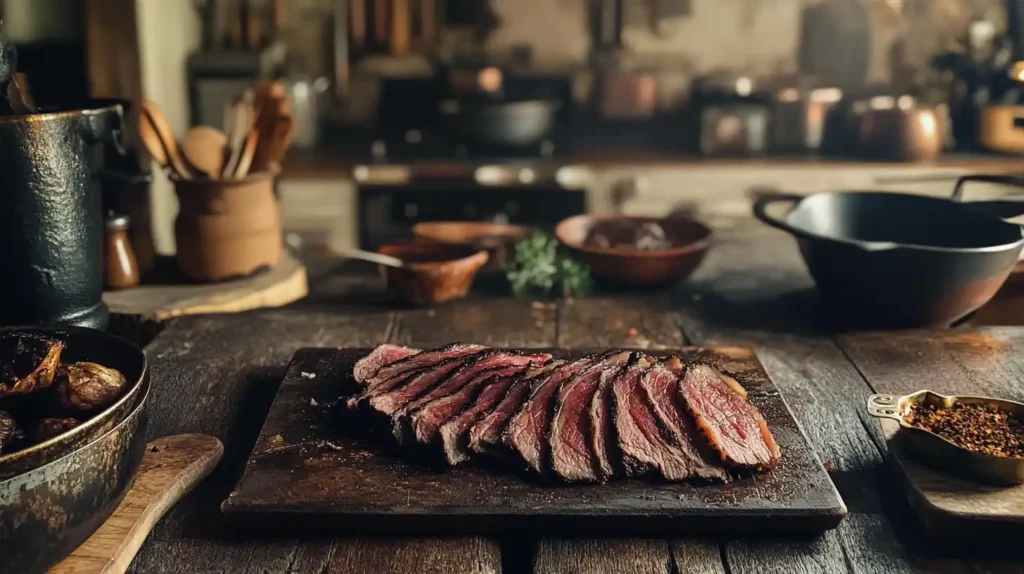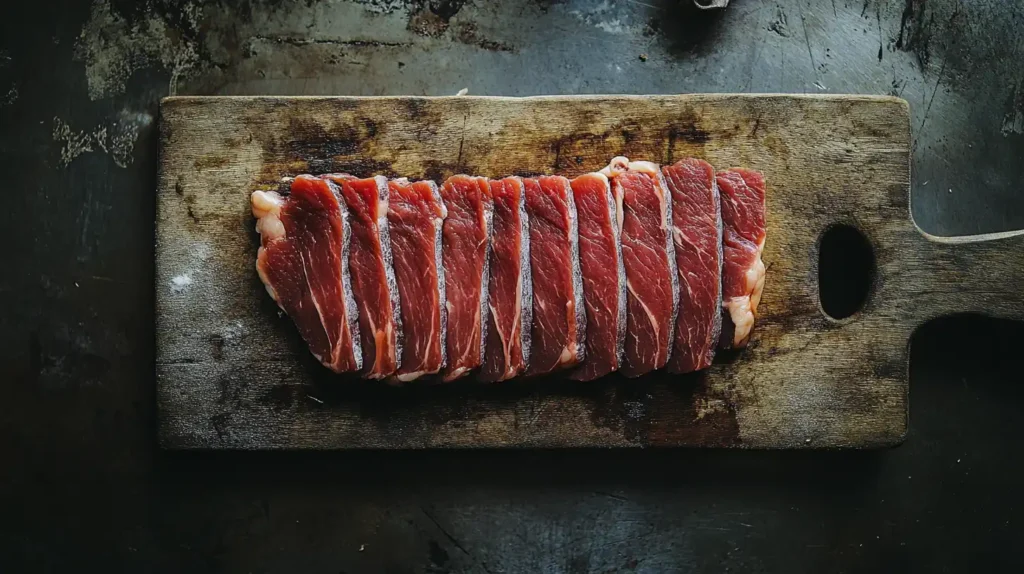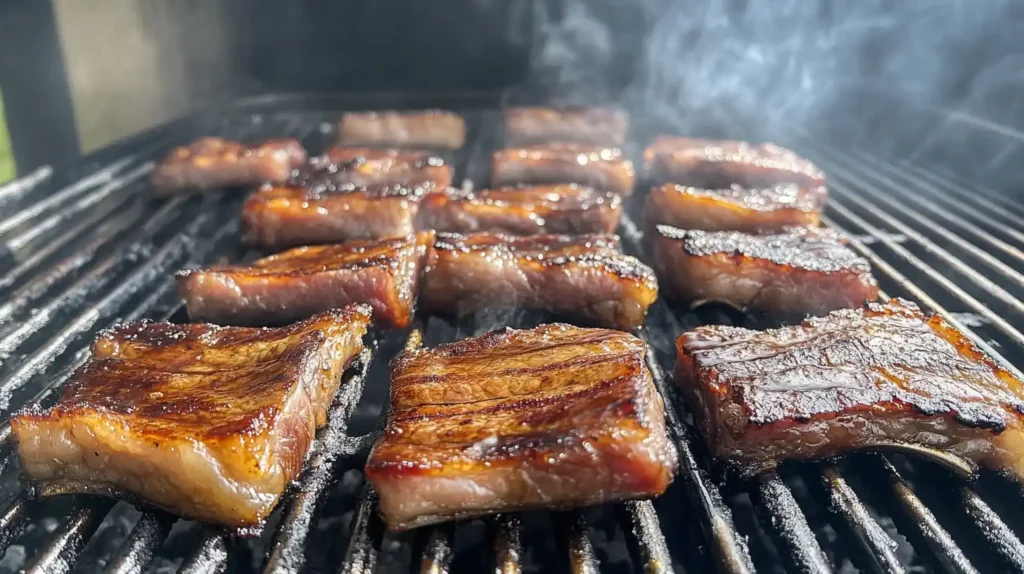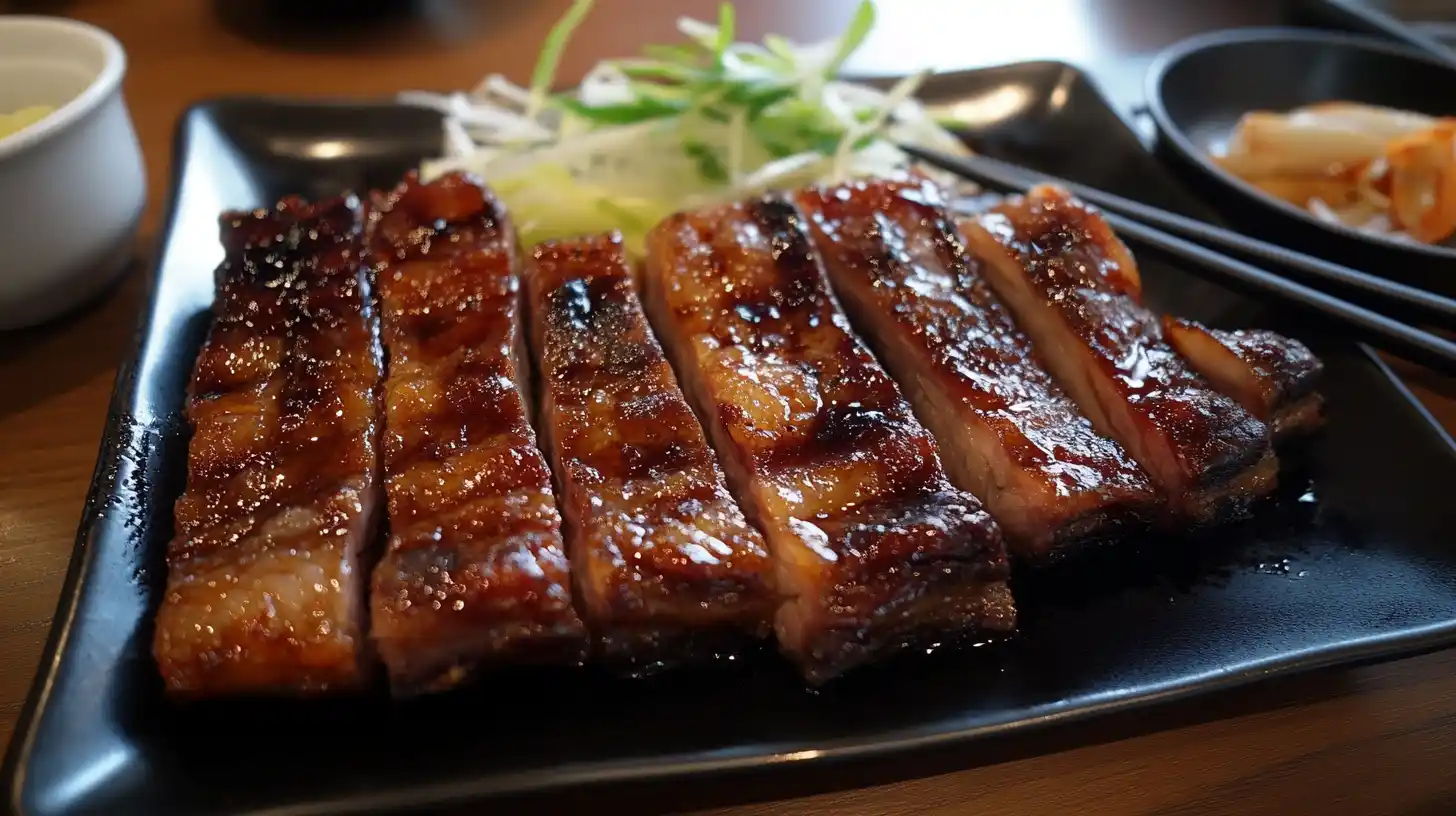If you love tender, juicy beef, then you will enjoy sliced beef belly. This fatty and flavorful cut is becoming more popular in different dishes. Since it has rich marbling, it turns soft and delicious when cooked the right way.
But what exactly is sliced beef belly, and why should you try it? In this guide, we will cover everything you need to know, from what it is to how to prepare it in different ways. Plus, you’ll learn how it compares to other beef cuts and why it’s so versatile.

What is Sliced Beef Belly?
Sliced beef belly comes from the underside of the cow, near the navel and short plate. This area contains high marbling and fat, which gives the meat a tender, juicy texture when cooked properly.
Unlike leaner cuts like sirloin or tenderloin, beef belly retains moisture, making it ideal for slow cooking, grilling, and roasting. Its fat content also helps it develop a rich, crispy exterior when seared at high temperatures.
If you’re interested in learning more about other flavorful cuts of beef, check out this comprehensive guide on sliced beef.
What Makes This Cut So Special?
There are several reasons why sliced beef belly is a favorite among beef lovers:
- Fatty and juicy – The fat melts as it cooks, creating a buttery taste.
- Rich in flavor – Because it has more fat, it is much tastier than lean cuts.
- Versatile – You can grill it, slow-cook it, or use it in stews and soups.
- Affordable alternative – It costs less than prime cuts, yet it still offers incredible taste and texture.
This cut is widely used in Korean BBQ, Chinese hot pot, and Western smoked dishes. Many people compare it to pork belly, but beef belly is leaner and has a deeper beefy flavor.

Nutritional Value of Sliced Beef Belly
If you are looking for a beef cut that is both delicious and nutritious, sliced beef belly is a great option. Since it contains a good balance of protein and fat, it fits well into diets like keto and high-protein meal plans.
Nutrition Per 100g of Sliced Beef Belly
- Calories: ~400 kcal
- Protein: ~17g
- Fat: ~35g
- Iron & Zinc: Important for muscle growth and immunity
- Collagen & Gelatin: Beneficial for joint and skin health
Because sliced beef belly is high in fat, it’s best enjoyed in moderation. To balance your meal, try pairing it with vegetables or whole grains.
Top Ways to Cook for the Best Flavor
Since sliced beef belly is full of fat and marbling, it becomes incredibly tender and flavorful when cooked properly. While there are many ways to prepare it, the following methods bring out the best taste and texture.
1. Grilling for a Smoky Flavor
Grilling is one of the best ways to cook sliced beef belly because it enhances the rich, meaty taste. Plus, the fat caramelizes over high heat, making the edges crispy and delicious.
Steps for Grilling:
Marinate with soy sauce, garlic, and sesame oil for 30 minutes.
Preheat the grill to medium-high heat so the beef cooks evenly.
Cook each side for 3-4 minutes until nicely charred.
Let it rest for a few minutes before slicing to retain the juices.
2. Slow-Cooking for Ultimate Tenderness
If you prefer soft, fall-apart beef, slow cooking is the best method. Since low heat breaks down the fat over time, the meat becomes incredibly tender and rich in flavor.
How to Slow Cook Beef Belly
Season with salt, pepper, and your favorite spices to enhance the taste.
Place in a slow cooker with beef broth or soy sauce for extra juiciness.
Cook on low for 6-8 hours until the meat is tender enough to pull apart.
Serve it with rice, mashed potatoes, or warm bread for a complete meal.
3. Stir-Frying for a Quick Meal
If you don’t have much time, stir-frying is a fast and tasty way to cook sliced beef belly. Since it cooks quickly, it remains juicy and full of flavor.
Quick Stir-Fry Recipe:
Slice beef belly into thin strips so it cooks evenly.
Heat a wok with sesame oil to bring out a nutty aroma.
Add garlic, onions, and bell peppers for extra flavor and crunch.
Toss in the beef belly and cook for 3-4 minutes until browned.
Add soy sauce and honey for a savory-sweet finish.

How Different Cuisines Use This Juicy Cut
Sliced beef belly appears in many cuisines because of its rich flavor and tender texture. Its high fat content makes it ideal for grilling, slow cooking, and stir-frying. Different cultures prepare it in unique ways, bringing out its best qualities.
1. Korean BBQ: Smoky and Savory Bites (Samgyeopsal)
In Korean cuisine, sliced beef belly is often grilled and served with dipping sauces. Unlike marinated meats, Korean BBQ focuses on letting the natural beef flavors shine.
- Served with kimchi, garlic, and lettuce wraps.
- Dipped in sesame oil with salt and pepper for added richness.
- Paired with fresh side dishes like pickled radish and rice.
How People Serve It
After grilling, they wrap the beef in lettuce leaves with garlic, chili, and kimchi. This creates a fresh, savory bite with a mix of textures and flavors.
Korean BBQ balances rich meat, fresh vegetables, and bold spices. The smoky beef belly pairs well with the crisp lettuce and fermented kimchi, making it a favorite in Korean cuisine.
2. Chinese Hot Pot and Braised Dishes
Chinese cooking often uses sliced beef belly in hot pot, stir-fries, and braised dishes. Its fat content allows it to absorb flavors and become incredibly tender when cooked in broth or sauce.
How Chefs Use It in Hot Pot
- Thin slices of beef belly cook in boiling broth within seconds.
- The melting fat gives the meat a rich, buttery texture.
- People dip the cooked beef in soy sauce, sesame oil, or spicy chili sauce.
Hot pot offers a fun, interactive way to cook beef belly. Since each person controls how long they cook their meat, they can adjust the texture to their liking.
How Cooks Prepare It in Stir-Fries
- They stir-fry the beef belly with garlic, ginger, and soy sauce over high heat.
- They add vegetables like bell peppers, onions, and bok choy for contrast.
- They serve it over rice or noodles for a complete meal.
Stir-frying keeps the beef belly tender while adding a smoky, slightly crispy texture. The quick cooking method helps retain its juiciness while blending well with vegetables and sauces.
3. Western BBQ and Smoked Beef Delicacies
Middle Eastern cooking highlights the deep, smoky flavors of sliced beef belly through grilling and slow cooking. Its natural fat keeps it juicy and tender, making it an excellent choice for kebabs and stews.
How Chefs Use It in Kebabs
- They marinate sliced beef belly with garlic, lemon, cumin, and paprika.
- They thread the meat onto skewers and grill it until golden brown.
- The kebabs are served with hummus, pita bread, and grilled vegetables.
These kebabs offer bold, smoky flavors that pair well with fresh sides like cucumber yogurt sauce or tahini. The marinade softens the beef, making it even more delicious.
How Families Prepare Slow-Cooked Stews
- They cook beef belly with tomatoes, onions, and warm spices over low heat.
- Slow cooking breaks down the fat, making the beef melt-in-your-mouth tender.
- The dish is served with rice or couscous for a hearty meal.
Slow-cooked stews allow flavors to develop fully, creating a deep, satisfying taste. The beef belly’s fat blends into the sauce, giving it a rich, velvety texture.
4. Western Cuisine: Sliced Beef Belly in BBQ and Smoked Dishes
Western BBQ and smoking techniques bring out the deep, smoky flavors of sliced beef belly. Since it has a high fat content, it stays moist and flavorful throughout slow cooking.
How Pitmasters Prepare It for BBQ
- They coat the beef belly with salt, pepper, paprika, and garlic powder.
- It smokes for 6-8 hours over low heat.
- Before serving, they glaze it with BBQ sauce for extra flavor.
BBQ-style beef belly becomes incredibly tender after hours of slow cooking. The rendered fat gives it a rich, bold taste, making it a favorite in American barbecue.
How People Use It to Make Crispy Beef Bacon
- They cure and smoke beef belly just like traditional bacon.
- They slice it thin and pan-fry it until crispy.
- It is served with eggs, toast, or in sandwiches.
Beef bacon provides a crispy, smoky meat option without using pork. While it has a slightly different texture, it still delivers the same satisfying crunch and deep umami flavor.
Why Sliced Beef Belly Works in So Many Cuisines
Sliced beef belly remains a favorite ingredient in many cultures because:
- Its high fat content makes it rich and juicy.
- The meat becomes soft and tender when cooked properly.
- It soaks up marinades and spices, blending well with different flavors.
- It suits many cooking methods, including grilling, slow cooking, stir-frying, and smoking.
This beef cut is both versatile and budget-friendly, making it an excellent choice for home cooks and professional chefs.
Where to Buy and How to Store It Properly
Finding high-quality sliced beef belly is essential for getting the best taste and texture. Here are some of the best places to buy it:
- Local butcher shops – Ask for beef belly or navel cut for the freshest options.
- Online meat delivery services – Many offer premium, grass-fed beef belly for better quality.
- Asian supermarkets – A great place to find thinly sliced beef belly for stir-frying or grilling.
How to Store Beef Belly Properly
To keep your beef belly fresh, follow these simple storage tips:
- Refrigeration: Store in an airtight container for up to 3 days.
- Freezing: Wrap in butcher paper or vacuum seal to keep it fresh for up to 6 months.
- Thawing: Place in the fridge overnight for safe defrosting.
By storing it the right way, you can enjoy sliced beef belly whenever you want without losing its great taste and texture.
FAQs: Common Questions About Sliced Beef Belly
Many people have questions about sliced beef belly, especially when trying to cook it for the first time. Here are some of the most frequently asked questions, along with clear and helpful answers.
1. Is sliced beef belly the same as brisket?
No, sliced beef belly and brisket come from different parts of the cow. Brisket comes from the lower chest, while beef belly comes from the underside, near the navel.
- Brisket has more muscle and less fat, making it firmer and leaner.
- Beef belly has more fat, which makes it softer and richer in flavor.
Both cuts are great for slow cooking, but beef belly has a more buttery texture when cooked properly.
2. How does beef belly compare to short ribs?
Short ribs and beef belly are both rich and flavorful, but they have key differences:
- Short ribs have more bone and connective tissue, which makes them perfect for braising.
- Beef belly has more fat and is boneless, making it better for grilling or frying.
Since beef belly has a higher fat content, it melts more easily during cooking, giving it a smoother texture.
3. Can I use sliced beef belly instead of pork belly in recipes?
Yes, you can substitute sliced beef belly for pork belly in many recipes, but there are a few differences to consider:
- Beef belly is leaner than pork belly, so it may not be as greasy.
- It has a stronger beef flavor, which changes the taste of some dishes.
- Cooking time may need adjusting since beef belly can cook faster or slower, depending on the method.
If a recipe calls for pork belly, try adding a bit more fat or oil when using beef belly to replicate the juiciness.
4. What is the best way to cook sliced beef belly for maximum tenderness?
The best way to cook sliced beef belly depends on the texture you want:
- For a crispy texture – Grill or pan-fry over high heat to sear the outside.
- For a tender, melt-in-your-mouth texture – Slow cook at low heat for several hours.
- For a balance of both – Braise it first, then finish by searing or grilling.
Since beef belly contains a lot of fat, cooking it slowly allows the fat to render, making the meat more tender.
5. Is sliced beef belly good for grilling?
Yes, sliced beef belly is excellent for grilling because of its fat content. The fat helps prevent the meat from drying out and adds extra flavor.
To grill it perfectly:
- Marinate the slices for at least 30 minutes to enhance the flavor.
- Use medium-high heat to get a nice char without burning the fat.
- Flip it frequently to ensure even cooking.
Grilled beef belly is commonly served in Korean BBQ and pairs well with fresh side dishes like kimchi, pickled vegetables, or rice.
6. Does beef belly contain a lot of fat?
Yes, beef belly is one of the fattier cuts of beef. Its high fat content gives it a rich, juicy flavor and makes it ideal for slow cooking.
If you prefer a leaner option, you can trim off some of the fat before cooking. However, removing too much fat may reduce the tenderness and flavor of the meat.
7. How do I make crispy beef belly?
To achieve crispy beef belly, use one of these cooking methods:
- Roasting at high heat – Bake in the oven at 400°F (200°C) until golden and crispy.
- Pan-frying – Cook in a dry pan over medium-high heat to render the fat and crisp up the edges.
- Air-frying – Use an air fryer at 375°F (190°C) for 15-20 minutes, shaking halfway through.
For extra crispiness, let the beef belly rest before slicing, so the fat firms up.
8. Can I use sliced beef belly for soups and broths?
Yes, sliced beef belly is great for soups and broths. Its high fat content enriches the broth, making it deep and flavorful.
For the best results:
- Simmer it slowly for several hours to extract the flavors.
- Use aromatic spices like garlic, ginger, and bay leaves.
- Skim the fat off the top if you prefer a lighter broth.
Beef belly is often used in Asian noodle soups and rich beef stews because it adds a silky texture to the dish.
9. Is sliced beef belly expensive?
No, sliced beef belly is more affordable than premium cuts like ribeye or tenderloin. However, the price may vary based on:
- Quality of the beef – Grass-fed or organic beef belly may cost more.
- Thickness of the slices – Thicker cuts usually cost more per pound.
- Where you buy it – Butcher shops and specialty meat stores may charge higher prices than supermarkets.
Despite its lower cost, beef belly delivers a rich, premium taste, making it a great choice for budget-friendly meals.
10. How do I tenderize beef belly before cooking?
Beef belly is naturally tender due to its fat content, but you can make it even softer with these methods:
- Marinate with acidic ingredients like vinegar, lemon juice, or soy sauce to break down fibers.
- Use a meat mallet to pound the slices before cooking.
- Cook it low and slow to allow the fat to melt and make the meat extra soft.
For the most tender results, try slow cooking first, then finishing with a quick sear for added texture.
Final Thoughts on Cooking and Enjoying This Delicious Beef Cut
Sliced beef belly is one of the most flavorful and versatile beef cuts available. Its rich fat content makes it incredibly juicy, while its tender texture allows it to work well with many cooking methods. Whether you grill, slow-cook, stir-fry, or braise it, this cut delivers a bold, satisfying taste in every bite.
Key Takeaways
- Full of flavor – The natural marbling makes it juicy and rich.
- Works in many cuisines – Popular in Korean BBQ, Chinese hot pot, Middle Eastern stews, and Western BBQ.
- Easy to cook – Great for both quick meals and slow-cooked dishes.
- Affordable choice – Offers a luxurious taste at a lower price compared to premium beef cuts.
- Perfect for different textures – Can be crispy, melt-in-your-mouth soft, or perfectly seared.
If you are looking for a delicious and budget-friendly beef cut, sliced beef belly is an excellent choice. It brings out the best flavors when cooked properly and pairs well with many seasonings and side dishes.

